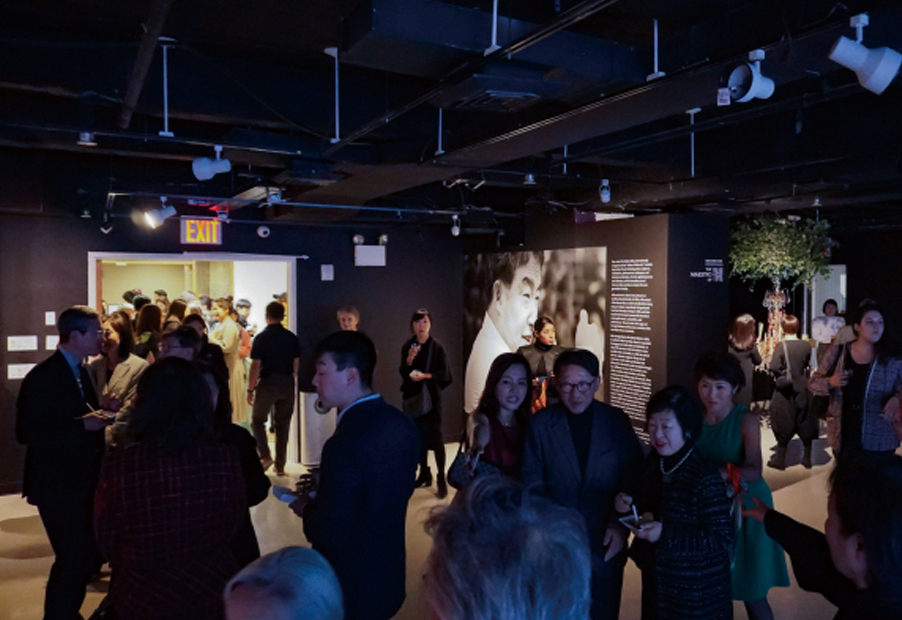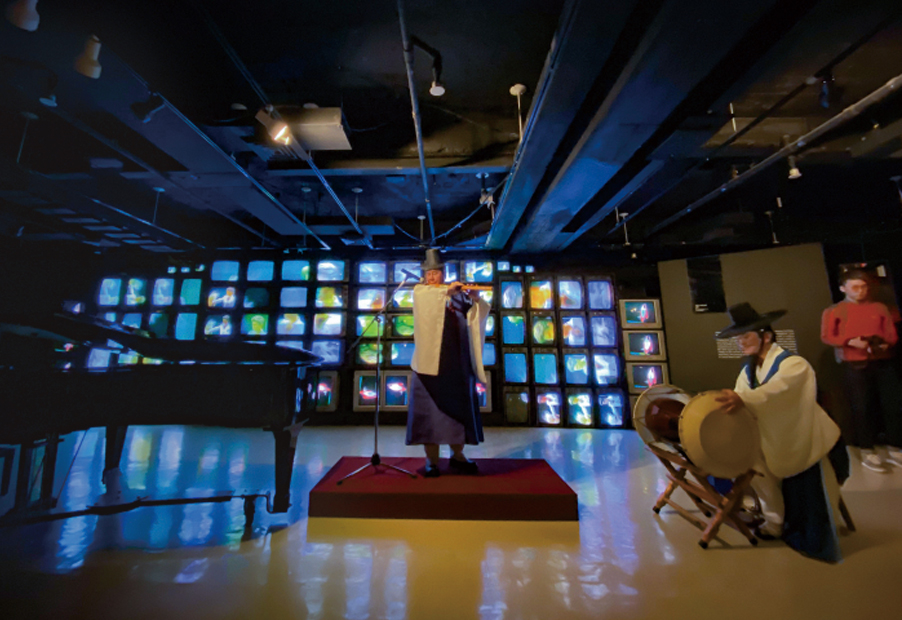Global Korea I
Remembering Paik Nam June
 New York
New York
Opened in December 1979, the KCC in New York last year celebrated its 40th anniversary, and to mark this milestone, an exhibition was held of the works of the late installation artist Paik Nam June.
The event’s opening reception began with a video covering the KCC’s history over the past 40 years and a performance by budding pianist Shin Chang-young. Welcoming speeches by distinguished guests based in New York were followed by a congratulatory performance by daegeum (large bamboo transverse flute) master Jang Hyeon-won, and the grand finale was an encore performance by Shin.
Attending the event included representatives from art and cultural institutions based in the Big Apple, as well as major artists and personnel who worked with Paik such as video editor Paul Garrin and Paik’s technician Adam Taye. Well-known Korean artists active in New York also dropped in.
Created to commemorate the 200th anniversary of Mozart’s death, the large video installation piece comprised 86 TV monitors that played a song arranged by Paik featuring the music of not only Mozart and popular contemporary musicians and artists such as John Cage, Merce Cunningham and Joseph Beuys, but also classical music, pop and mechanical sounds.
Global Korea I
Small Theater Festival Held
in Hungary
 Hungary
Hungary
The small theater festival “ÚJ KEZDET,” which comprises four consecutive performances, was held in Hungary to mark the 30th anniversary of Korean-Hungarian relations and the opening of the relocated KCC in Budapest. Designed to introduce the new space and direction of the KCC, the festival featured performances in a range of genres including classical and fusion music, contemporary dance and jazz.
A cello concert given by students from the music academy and center for gifted children at Korea National University of Arts opened the event. Next was the concert “Beginning Anew” by the musical band Froms, which is active in the U.K., and the performance, “Tail Language,” based on an art project led by contemporary dance choreographer Kim Bo-ra. The finale was “Strange Liberation” by Soojin Suh Chordless Quartet from Jazz Korea, the festival’s host. Each of the performances received warm applause from the audience.
Since its relocation, the KCC in Hungary is the biggest in Europe in space and second among all 32 KCCs worldwide.
Global Korea II
What do Spaniards think of
Bong Joon-ho’s film ‘Parasite’?
Written by • Korea.net Honorary reporter Susana Matondo from Spain
“Parasite” by director Bong Joon-ho on Jan. 5 won the Golden Globe for best foreign-language film, having emerged as a cinematic phenomenon last year.
This movie has also been successful in Europe, winning the top prize at the Cannes Film Festival and grossing EUR 1 million in Spain just a month after its release in November last year. Film critics and audiences agree that “Parasite” is thrilling, shocking and witty, with symbolism and social criticism that are initially subtle but become brutally clear.
So what do Spaniards think of this film? Most love it despite a few points that seem unclear to some. “Parasite” implies something is wrong with the privileged class and capitalism, and goes further.
One viewer named Javi was infatuated with Bong’s style, adding that he loved “how the narrative was built and executed to the very end. The movie becomes agonizing when the action moves into the basement. The dark lighting and uncertainty made me feel like I was watching a horror film at some points.”
Most surprising, he said, were its ingenious portrayals of class differences, the poor’s capacity to adapt and an apprehensive unpredictability where “you sense it won’t end happily but rather, leave audiences to ruminate.”
Another viewer, Isabel, felt similarly, noting the undeniable tension. “I liked the pace and plot twists, though sometimes the rich family’s unawareness of their own basement seemed unrealistic.” She also speculated how “interesting it would be to see the rich family as ‘parasites,’ perhaps tinged with corruption.” This opinion resonates with critics who said the privileged family is also a kind of parasite needing its own parasites to survive. After all, what would they do without servants, chauffeurs and private tutors?
On what impressed her the most, viewer Laura was hesitant to single out one facet, but cited the sensitivity of the chosen spaces, where “open, wide and bright spaces are reserved for the rich and dark, narrow spaces for the poor.” She also noted the hopelessness of how “society’s fixed structure grants neither chances nor escape for the poor family.” This is shown through the identical imagery of the first and final scenes. “The necessary replacement of one parasite with another to maintain the social system is a huge social metaphor,” she commented.
Personally, I found a few impressive key points. From the onset, the poor family subsist like parasites while their humble semi-basement abode is fumigated. The thrilling discovery of the rich family’s basement also indicates the necessity of “parasites” to retain the status quo. Manifest in “the smell” is a symbol for the selfishness and ignorance of the privileged: an element representative of the gap between social classes and which spurs the masterful ending.
While I see Bong’s work as a new breed of cult film, Javi’s interpretation is worth noting: “‘Parasite’ is not a film you watch to kill time, but one to mull over.”

© CJ Entertainment
























